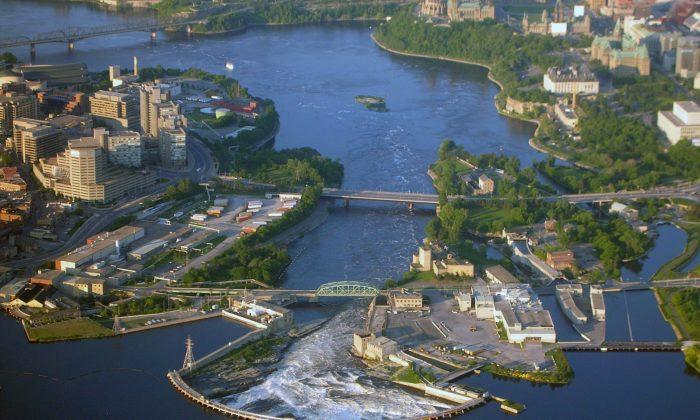French explorer Samuel de Champlain waxed lyrical about them, poems were written about them, they have been painted, photographed, and put on postcards, and Foreign Affairs Minister John Baird has called them a national treasure.
They are the Chaudière Falls on the Ottawa River—just a stone’s throw from Parliament Hill—which at one time were considered second only to Niagara Falls as a natural wonder, although possibly more interesting in their variety.
But the damming of the river as the area became industrialized greatly altered the falls’ appearance, especially in the summer when the Ottawa River is low and the falls are reduced to a trickle as the water is diverted to power stations.
For years before his death in 2011, famed Algonquin elder and spiritual leader William Commanda advocated “freeing the falls” from dams. Now, with new development slated for the area, an Ottawa resident is renewing Commanda’s calls to release the falls from industrial use and restore them to their former glory.
“It’s a phenomenal site, a natural wonder,” says Lindsay Lambert, an Ottawa-based historian who has been collecting pre-dam images to raise awareness of the Chaudière Falls’ original grandeur.
“The unfortunate part is it’s beyond living memory—people don’t know what’s there.”
The shape of the falls before development resembled a large cauldron. According to Lambert, there was an area toward the Quebec side that was completely surrounded by stone. The water would flow in but wouldn’t come out again, much to the amazement of visitors.
“It was travelling through an underground channel and reappearing in the river further downstream. The falls have been described as ‘a hundred rivers struggling for a passage,’” he says.
Lambert would like to see the 37-acre site slated for development, known as the Domtar lands, turned into a public space and national “showpiece” where tourists and locals alike could enjoy a spectacular view of the unbridled falls, which are about 60 metres (200 ft) wide and drop 15 metres (49 ft).
He would also like to see Commanda’s vision realized. Commanda proposed naturalizing the falls and turning the area—which served as a sacred meeting place for the Algonquin people for thousands of years—into a national historic centre.
The area, which includes the falls as well as Chaudière and Victoria Islands, was also a key portage route for all the great Canadian explorers, one of the earliest sites of human occupation in Canada, and the birthplace of Ottawa’s logging industry and other key sectors.
Commanda, who over his lifetime received numerous awards including the Order of Canada and a key to the City of Ottawa, envisioned that the site would include a city park, a historic interpretative site, a conference centre, and an aboriginal centre.
Lambert believes honouring Commanda’s legacy and vision would “do a lot” toward healing relations between aboriginals and the government.
Mixed-use Community, New Dam
But Ottawa-based Windmill Development Group has recently signed an agreement to purchase the site—which does not include the falls themselves or Victoria Island—and hopes to revamp the abandoned industrial land. The National Capital Commission (NCC) also made a bid for the site in 2012 but was turned down by the Treasury Board.
Windmill has said it hopes to turn the area into “Canada’s most sustainable mixed-use community”—a blend of residential, retail, commercial, and public uses akin to the Distillery District in Toronto or Vancouver’s Granville Island development. The mayors of both Ottawa and Gatineau, as well as the NCC, support the plan.
Initial public consultations and meetings with “hundreds of interested parties” have garnered mostly positive feedback, says Rodney Wilts, a partner at Windmill.
“This area has been cordoned off from the public for longer than any of us have been alive. It is certainly our intent to open the site back up and make it a place where the public can go and have an urban experience on the water,” he says.
He adds that the company has had “productive” meetings with the Algonquin First Nations and is supportive of Commanda’s vision.
“In general strokes, they share our values of sustainability, want to ensure access to the falls, and want to ensure that the history of the site is made known through the development—those are all things we support,” Wilts says.
With the privatization of the land moving forward, Lambert’s vision for naturalizing the falls has met with another obstacle: Hydro Ottawa plans to build a new 28-megawatt hydroelectric generating facility, adjacent to two existing stations at Chaudière Falls.
An initial design for the facility has been completed and awaits environmental and regulatory approval, says Owen Mahaffy, communications director for Hydro Ottawa, adding that the expansion will allow “greater public access” to the falls.
Mahaffy says the utility will also work with Windmill and other stakeholders to revamp the site.
“Hydro Ottawa is actively involved with other stakeholders in the redevelopment of this site into a tourist attraction and historic showpiece,” he says.
In the meantime, Lambert plans to continue to advocate for freeing the falls while raising public awareness about their beauty through his antique photos, postcards, and souvenirs.
“I’m just one voice. I’m hoping that it will get others talking,” he says.





Friends Read Free